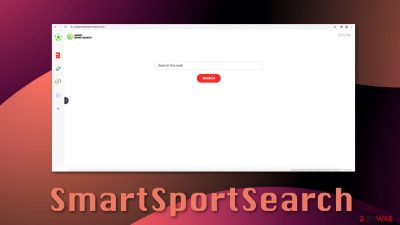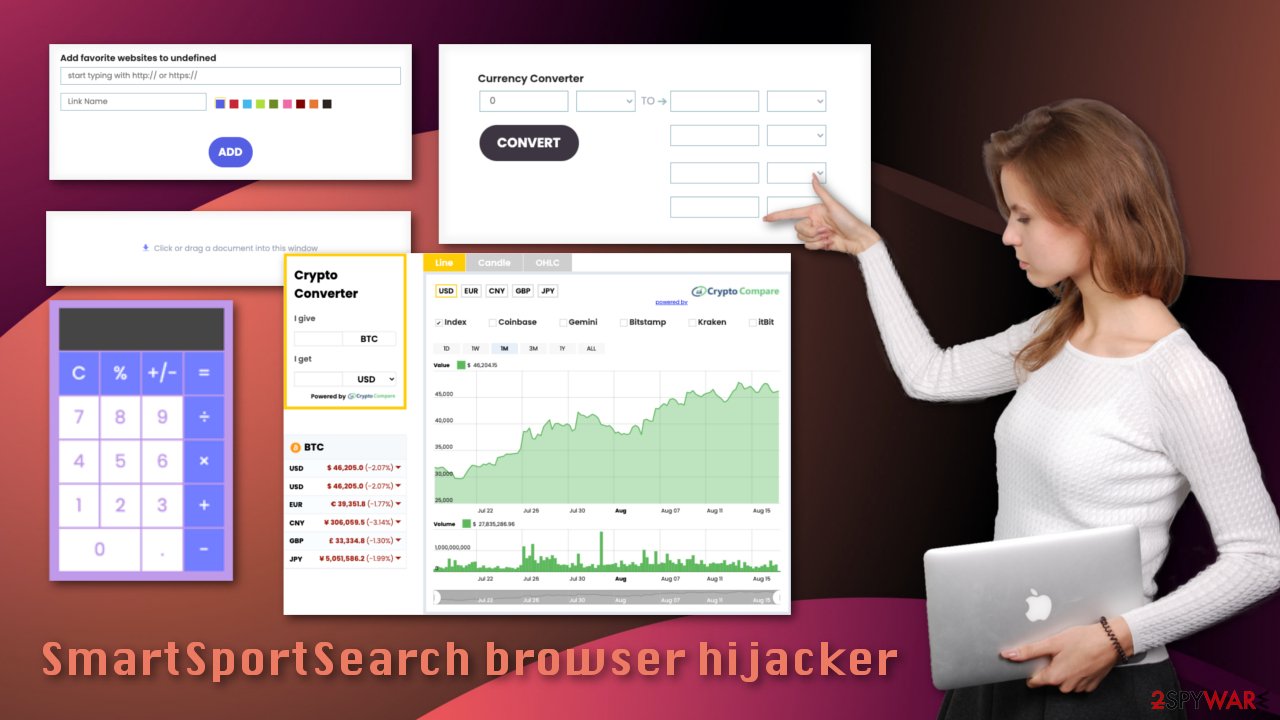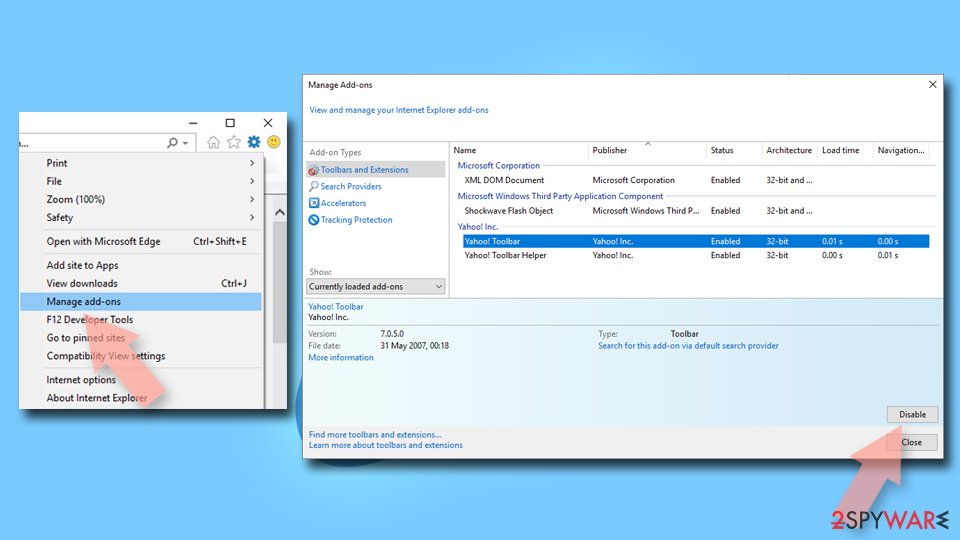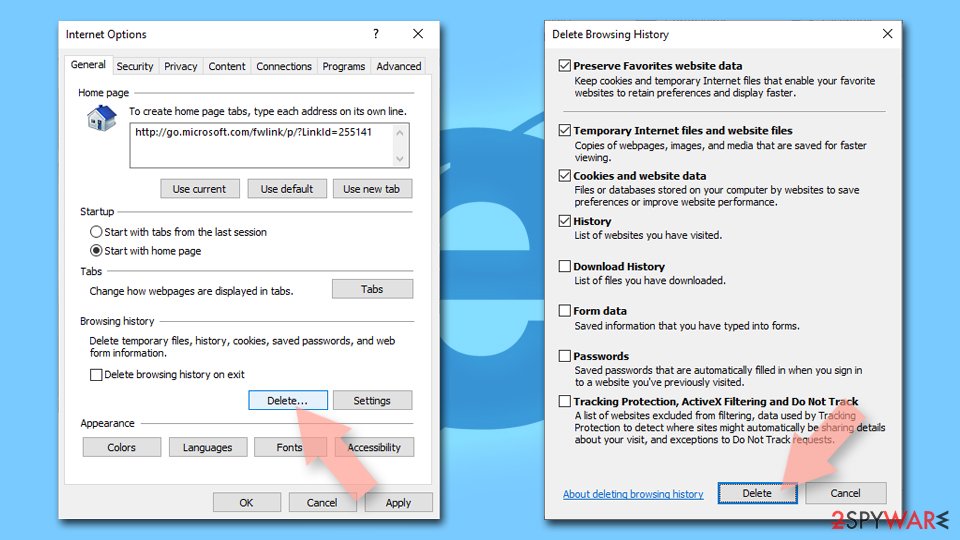SmartSportSearch browser hijacker (fake) - Free Instructions
SmartSportSearch browser hijacker Removal Guide
What is SmartSportSearch browser hijacker?
SmartSportSearch uses helpful tools to disguise its true intentions

SmartSportSearch can do things with your browser that you did not intend to do yourself. For this reason, it is classified as a hijacker.[1] When your browser is hijacked, you might find that your previous default homepage has changed (in this case, set to portal.smartsportsearch.com, which redirects to nearbyme.io, Yahoo, or another provider once used), or the search engine is not Google anymore but a different one instead. This browser extension can also insert unwanted ads in your browsers' search results.
Due to the major increase in internet usage over the past decade, it has become more rewarding for authors of useless apps to employ browser hijacking feature.
The purpose of ads is to direct someone to a certain page and increase traffic on the site. The point is to get as many people to click the ads as possible because the creators are paid by the number of clicks on ads.[2] This means that whenever the hijacker generates more traffic to a website, the higher the profit. Because of this, ads shown on SmartSportSearch search are not all filtered, and some of them might be inaccurate or even less secure.
| NAME | SmartSportSearch |
| TYPE | Browser hijacker, unwanted extension |
| DISTRIBUTION | Bundled software, deceitful advertisements |
| SYMPTOMS | Default homepage changed; a customized search engine with altered search results |
| DANGERS | Links that are not disclosed as ads might lead to dangerous websites, where users' private information can be vulnerable |
| ELIMINATION | An unwanted extension is easy to get rid of manually with the help of our guide |
| FURTHER STEPS | FortectIntego can help you clean your browsers and fix any damage left after the removal |
Hijackers' distribution methods
The simplest way hijackers get spread is by masking plugins as useful tools so that users would add them themselves or with social engineering tactics by deceptive ads or phishing emails. A more complicated method is hiding an extension during the installation process of freeware.
Because of this, it is crucial to always read the steps carefully when installing software from non-official sources. Look for checkboxes near unusual-looking names that do not seem to be related to the program you are downloading. A more obvious rule would be to not open any attachments or URLs in emails you do not trust.
While surfing the web, it is bad practice to click on random links. Google's Safe Browsing List[3] can help you avoid suspicious websites, and you should trust this function. If you clicked on a site and a warning message pops up saying that you better not proceed, you should do just that. Some of the possible warnings from Google are:
- The site ahead contains malware: The site that you want to visit might try to install harmful software, called malware, on your computer.
- Deceptive site ahead: The site that you want to visit might be a phishing site.
- Suspicious site: The site that you want to visit seems suspicious and may not be safe.
- The site ahead contains harmful programs: The site that you start to visit might try to trick you into installing programs that cause problems when you’re browsing online.
- This page is trying to load scripts from unauthenticated sources: The site that you try to visit isn't secure.
To remove an unwanted add-on from your browser, you will have to do it manually by going to your browser settings. If you follow our instructions, this should be a quick and easy process.
Google Chrome:
- Open Google Chrome, click on the Menu (three vertical dots at the top-right corner) and select More tools > Extensions.
- In the newly opened window, you will see all the installed extensions. Uninstall all the suspicious plugins that might be related to the unwanted program by clicking Remove.
![Remove extensions from Chrome Remove extensions from Chrome]()
Microsoft Edge:
- Select Menu (three horizontal dots at the top-right of the browser window) and pick Extensions.
- From the list, pick the extension and click on the Gear icon.
- Click on Uninstall at the bottom.
![Remove extensions from Edge Remove extensions from Edge]()
Microsoft Edge (Chromium):
- Open Edge and click select Settings > Extensions.
- Delete unwanted extensions by clicking Remove.
![Remove extensions from Chromium Edge Remove extensions from Chromium Edge]()
Safari:
- Click Safari > Preferences…
- In the new window, pick Extensions.
- Select the unwanted extension and select Uninstall.
![Remove extensions from Safari Remove extensions from Safari]()
Mozilla Firefox:
- Open Mozilla Firefox browser and click on the Menu (three horizontal lines at the top-right of the window).
- Select Add-ons.
- In here, select unwanted plugin and click Remove.
![Remove extensions from Firefox Remove extensions from Firefox]()
Internet Explorer:
- Open Internet Explorer, click on the Gear icon (IE menu) on the top-right corner of the browser
- Pick Manage Add-ons.
- You will see a Manage Add-ons window. Here, look for suspicious plugins. Click on these entries and select Disable.
![Remove add-ons from Internet Explorer Remove add-ons from Internet Explorer]()
Preventing the problem is easier if you know the fundamentals
A good technique in putting a stop to intruders from ruining your online experience is knowing what the traits of browser hijackers are:
- Weird new toolbars you cannot remove (SmartSportSearch has a PDF converter, calculator, regular currency, and cryptocurrency converter and an option to save your favorite websites)
- Cannot explain how the homepage settings changed (In this case, your landing page possibly changed to feed.smartsportsearch.com or portal.smartsportsearch.com)
- Search results look unusual and different (Different style, text, colors)
- Redirects to unintended websites (Pages with bad intentions, showing you fake error, warning messages, suggesting you download questionable software)
To prevent add-ons appearing with unwanted behavior, you should:
- Update your operating system and the browsers you regularly use because developers release patches for discovered vulnerabilities
- Clear cookies and cache
- Avoid questionable websites. Check URLs for any grammar mistakes. Make sure the connection is secure and look for the S in HTTPS because the HTTP connection is not encrypted[4], and anyone can access the information you provided on a page like that
- Practice safe email protocol, which includes not opening messages from unknown senders, not opening any attachments or file-sharing requests if you were not expecting them, get rid of messages you suspect to be spam
- Carefully evaluate free software and file-sharing applications before downloading them, do your research, read the reviews

After detection and widespread awareness, hijackers appear with the same functionality and appearance but different domain names. SmartSportSearch.com is just one of many browser hijackers from the same family. Here is a list of a few well-known examples:
After removal, please clear your cookies and cache to remove any remaining information suspicious websites gathered about you. You can do this yourself, or you can trust our recommendations and use FortectIntego, which will do this for you automatically.
Clear cookies and cache from Chrome:
- Click on Menu and pick Settings.
- Under Privacy and security, select Clear browsing data.
- Select Browsing history, Cookies and other site data, as well as Cached images and files.
- Click Clear data.
![Clear cache and web data from Chrome Clear cache and web data from Chrome]()
Microsoft Edge:
- Click on the Menu (three horizontal dots at the top-right of the browser window) and select Privacy & security.
- Under Clear browsing data, pick Choose what to clear.
- Select everything (apart from passwords, although you might want to include Media licenses as well, if applicable) and click on Clear.
![Clear Edge browsing data Clear Edge browsing data]()
Safari:
- Click Safari > Clear History…
- From the drop-down menu under Clear, pick all history.
- Confirm with Clear History.
![Clear cookies and website data from Safari Clear cookies and website data from Safari]()
Mozilla Firefox:
- Click Menu and pick Options.
- Go to Privacy & Security section.
- Scroll down to locate Cookies and Site Data.
- Click on Clear Data…
- Select Cookies and Site Data, as well as Cached Web Content and press Clear.
![Clear cookies and site data from Firefox Clear cookies and site data from Firefox]()
Internet Explorer:
- Press on the Gear icon and select Internet Options.
- Under Browsing history, click Delete…
- Select relevant fields and press Delete.
![Clear temporary files from Internet Explorer Clear temporary files from Internet Explorer]()
Freeware is the biggest playground for potentially unwanted programs
Another reason you might be experiencing sudden changes in your search engine is that you have a PUP installed in your system. These programs sometimes are disguised by creators as handy tools, but in reality, they are often not even functional. Instead, they perform tasks in the background without your knowledge, like collecting data about your browsing behavior, injecting ads in your browsers, and changing important settings.
Removing these applications can be tricky, as users cannot distinguish which programs they have could be responsible for such things. In such case, it is good to have antivirus software that is secure and trusted, like SpyHunter 5Combo Cleaner and Malwarebytes. These tools can help you detect unwanted programs, malware and help you remove them. If you know what app is responsible, you can follow our manual instructions below.
Getting rid of SmartSportSearch browser hijacker. Follow these steps
Uninstall from Windows
Instructions for Windows 10/8 machines:
- Enter Control Panel into Windows search box and hit Enter or click on the search result.
- Under Programs, select Uninstall a program.

- From the list, find the entry of the suspicious program.
- Right-click on the application and select Uninstall.
- If User Account Control shows up, click Yes.
- Wait till uninstallation process is complete and click OK.

If you are Windows 7/XP user, proceed with the following instructions:
- Click on Windows Start > Control Panel located on the right pane (if you are Windows XP user, click on Add/Remove Programs).
- In Control Panel, select Programs > Uninstall a program.

- Pick the unwanted application by clicking on it once.
- At the top, click Uninstall/Change.
- In the confirmation prompt, pick Yes.
- Click OK once the removal process is finished.
Delete from macOS
Remove items from Applications folder:
- From the menu bar, select Go > Applications.
- In the Applications folder, look for all related entries.
- Click on the app and drag it to Trash (or right-click and pick Move to Trash)

To fully remove an unwanted app, you need to access Application Support, LaunchAgents, and LaunchDaemons folders and delete relevant files:
- Select Go > Go to Folder.
- Enter /Library/Application Support and click Go or press Enter.
- In the Application Support folder, look for any dubious entries and then delete them.
- Now enter /Library/LaunchAgents and /Library/LaunchDaemons folders the same way and terminate all the related .plist files.

How to prevent from getting browser hijacker
Stream videos without limitations, no matter where you are
There are multiple parties that could find out almost anything about you by checking your online activity. While this is highly unlikely, advertisers and tech companies are constantly tracking you online. The first step to privacy should be a secure browser that focuses on tracker reduction to a minimum.
Even if you employ a secure browser, you will not be able to access websites that are restricted due to local government laws or other reasons. In other words, you may not be able to stream Disney+ or US-based Netflix in some countries. To bypass these restrictions, you can employ a powerful Private Internet Access VPN, which provides dedicated servers for torrenting and streaming, not slowing you down in the process.
Data backups are important – recover your lost files
Ransomware is one of the biggest threats to personal data. Once it is executed on a machine, it launches a sophisticated encryption algorithm that locks all your files, although it does not destroy them. The most common misconception is that anti-malware software can return files to their previous states. This is not true, however, and data remains locked after the malicious payload is deleted.
While regular data backups are the only secure method to recover your files after a ransomware attack, tools such as Data Recovery Pro can also be effective and restore at least some of your lost data.
- ^ Chris Hauk. Browser Hijacking: What Is It And How Can You Prevent It?. PixelPrivacy. Safety Guide.
- ^ Wikipedia. Pay-per-click. Wikipedia. Free Encyclopedia.
- ^ Google. Safe Browsing Lists. Google. Safe Browsing.
- ^ Google. Check if a site's connection is secure. Google. Help Center.
















